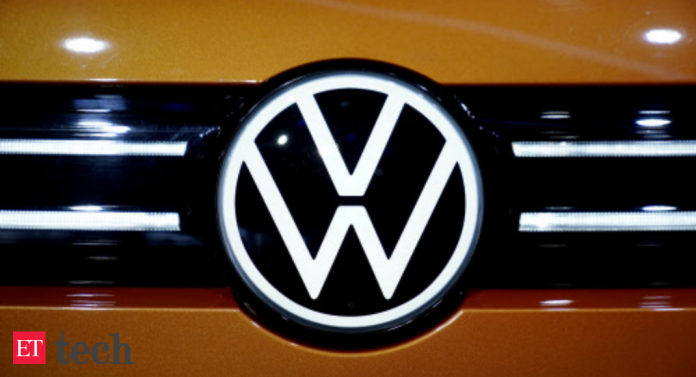By ensuring there are enough fast-charging plugs – and enough power – for the EVs it wants to sell, Europe’s biggest carmaker hopes to convince drivers worried about battery ranges that they can ditch their fossil fuel cars for good.
Underlining its electric ambition, Volkswagen has drafted in power industry veteran Elke Temme, who spent nearly two decades at German energy companies RWE and Innogy, to help the carmaker get in better shape to take on Tesla.
In the job since January, Temme, 53, has been tasked with bundling the carmaker’s various power activities such as procuring energy, enabling customers to charge their cars at home, and on the road, and selling the electricity required.
Getting this done will require a bigger workforce and Temme plans to double the staff at Volkswagen’s European charging and energy division, known as Elli, to about 300 in 2022, having already tripled it this year, she told Reuters in an interview.
“We’re investing in huge growth areas that don’t always have to be profitable right away. We always see these investments in the overall context of our group strategy,” she said. “That’s why building up a comprehensive infrastructure is key.”
Temme declined to specify the budget she has been given but said Volkswagen, led by Tesla admirer Herbert Diess, has approved the investment requests for the division, which also sells home battery storage systems similar to Tesla’s Powerwall.
Volkswagen leads the pack worldwide by far with its investment plans for EVs and batteries through 2030, according to a Reuters analysis, and it is planning to spend 35 billion euros on battery EVs by 2025. Global automaker EV & battery investments.
PLAYING CATCH UP
But when it comes to the networks of fast-chargers that many analysts believe are crucial for bringing EVs into the mainstream, VW has some catching up to do.
Tesla has been rolling out high-performance Superchargers for years and has a global network of about 30,000 fast-chargers that it says can give a 200 km (125 mile) boost in 15 minutes.
The company said in October that its own network has doubled in the past 18 months – and will triple over the next two years.
Volkswagen, meanwhile expects its network of fast-chargers to nearly quadruple to about 45,000 by 2025 – when it aims to overhaul Tesla as the global EV market leader – with 18,000 EV pumps in Europe, 17,000 in China and 10,000 in North America.
Volkswagen in March said it plans to spend 400 million euros on expanding its fast-charging network on the continent by then.
But that’s a drop in the ocean compared with the 5 billion euros the European Union reckons is needed every year until 2040 to expand charging infrastructure on the continent, and it is raising the pressure on utilities and governments to step up.
In Europe, the Volkswagen group is a shareholder in the EU’s fast-charging venture Ionity, along with rival carmakers BMW, Daimler’s Mercedes-Benz, Ford and Hyundai.
It has also teamed up with energy firms such as Italy’s Enel, Britain’s BP and Spain’s Iberdrola to plug geographical gaps and form the blueprint for how funding for EV infrastructure can be split across industries.
“Various models are conceivable, from product partnerships and joint ventures to M&A,” said Temme. Global automaker EV & battery investments, https://graphics.reuters.com/CLIMATE-UN/AUTOS-EV/myvmnkgmypr/chart.png
CARS AND POWER
Tesla has already shown that when it comes to EVs, just selling cars no longer cuts it. It has adopted a model that offers customers everything from cars to battery storage to solar panels as well as electricity https://reut.rs/3FjTlc2 in some U.S. states.
Volkswagen is now selling power to retail clients that drive an EV or plug-in hybrids. One of its tariffs – which is available to customers who don’t own a VW – has attracted more than 10,000 clients since its launch in July, Temme said.
She said VW was planning to make its fast-chargers available for all EV drivers, unlike Tesla which has so far kept its supercharging network just for Tesla drivers – with the exception of a pilot programme in the Netherlands.
“We are pursuing a different approach than Tesla when it comes to charging infrastructure roll-out,” said Temme.
“We want an open, non-discriminatory charging network and will develop our services to make our offer more comfortable, simpler, more attractive.”
Volkswagen says its open-for-all approach means buyers of its EVs can charge at more than 250,000 existing public charging points across Europe – from various providers with various charging speeds.
The problem is that charging protocols and payment methods can vary across vendors, potentially turning the act of refueling an EV into a time-consuming and messy undertaking.
From the first quarter of 2022, Volkswagen plans to offer “Plug & Charge” technology in Europe to make the process smoother.
The car will store the owner’s payment details and make a contactless payment when the charging plug is attached to the EV at refuelling stations set up for the service.
While these are new challenges for established carmakers, Temme, who witnessed first-hand the abrupt shift of Germany’s utilities away from nuclear power in the wake of the Fukushima disaster, believes they can be mastered.
“Utilities must reinvent themselves and transition from nuclear and coal to renewables. In the automotive industry, including at Volkswagen, the question is currently how to consistently shift the focus from conventional vehicles to sustainable mobility,” she said.
“These challenges are of similar magnitude.”
Reuters’ Tom Kackenhoff contributed to this story.

























